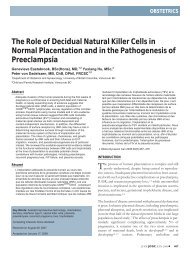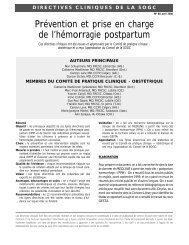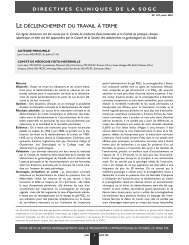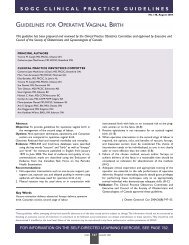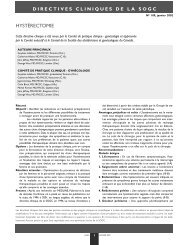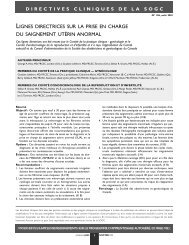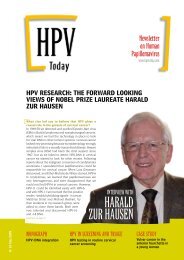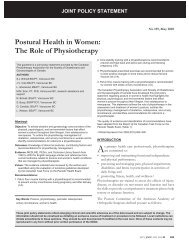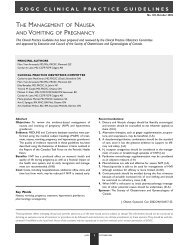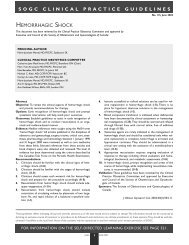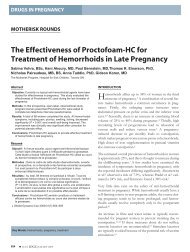Breast self-examination - SOGC
Breast self-examination - SOGC
Breast self-examination - SOGC
You also want an ePaper? Increase the reach of your titles
YUMPU automatically turns print PDFs into web optimized ePapers that Google loves.
<strong>Breast</strong> Self-Examination<br />
This committee opinion was developed by the <strong>Breast</strong> Disease<br />
Committee of the Society of Obstetricians and Gynaecologists of<br />
Canada. It was approved by the Executive and Council of the<br />
Society of Obstetricians and Gynaecologists of Canada.<br />
PRINCIPAL AUTHOR<br />
Vera Rosolowich, RN, SCM, IBCLC, Winnipeg MB<br />
BREAST DISEASE COMMITTEE MEMBERS<br />
Robert H. Lea, MD, FRCSC, Glen Haven NS, Chair<br />
Pierre Levesque, MD, FRCSC, Rimouski QC<br />
Fay Weisberg, MD, FRCSC, Toronto ON<br />
James Graham, MD, FRCSC, Halifax NS<br />
Lynne McLeod, MD, FRCSC, Halifax NS<br />
Vera Rososlowich, RN, SCM, IBCLC, Winnipeg MB<br />
Abstract<br />
Objective: To examine the value of teaching regular breast<br />
<strong>self</strong>-<strong>examination</strong> (BSE).<br />
Outcome: Reduction of benign biopsy rates.<br />
Benefits: To provide better advice for women about the risks and<br />
benefits of BSE, and to ensure that women who choose to practise<br />
BSE are taught to perform it proficiently.<br />
Summary Statement: Routine teaching of BSE does not reduce<br />
mortality and likely increases benign biopsy rates. (I)<br />
Recommendations:<br />
1. <strong>Breast</strong> <strong>self</strong>-<strong>examination</strong> should not be routinely taught to<br />
women. (ID)<br />
2. A full discussion of breast <strong>self</strong>-<strong>examination</strong>, including risks, should<br />
be provided for the woman who requests it. (IIIA)<br />
3. If a woman makes an informed decision to practise BSE, care<br />
providers should ensure she is taught the skills and that she<br />
performs <strong>self</strong>-<strong>examination</strong> proficiently. (IIIA)<br />
Validation: This committee opinion was developed by the <strong>Breast</strong><br />
Disease Committee of the Society of Obstetricians and<br />
Gynaecologists of Canada. It was approved by the Executive and<br />
Council of the Society of Obstetricians and Gynaecologists of<br />
Canada.<br />
Sponsor: The Society of Obstetricians and Gynaecologists of<br />
Canada.<br />
Key Words: <strong>Breast</strong> <strong>self</strong>-<strong>examination</strong>, breast cancer,<br />
mammography, mortality<br />
728 AUGUST JOGC AOÛT 2006<br />
<strong>SOGC</strong> COMMITTEE OPINION<br />
<strong>SOGC</strong> Committee Opinion<br />
J Obstet Gynaecol Can 2006; 28(8):728–730<br />
BACKGROUND<br />
Since the release of recommendations by the Canadian<br />
Task Force on Preventive Health Care in 20011 women<br />
have been confused about the value of regular breast<br />
<strong>self</strong>-<strong>examination</strong> (BSE). A review of the evidence not only<br />
showed that regular BSE conferred no benefit in terms of<br />
survival from breast cancer, but also provided evidence of<br />
harm. A 19942 review concluded that there was insufficient<br />
evidence to include or exclude teaching at the periodic<br />
health exam. The addition of “harms” in the 2001 update<br />
led to the recommendation that “routine teaching of BSE<br />
be excluded from the periodic health exam of women in the<br />
40 to 49 and the 50 to 69 age groups.” At the time of release<br />
there was an outcry in the media from cancer organizations<br />
and women’s groups, and there was a concomitant<br />
outpouring in the professional journals.<br />
Lerner 3 sets it in the historical context. Systematic BSE has<br />
been recommended for more than 70 years and promoted<br />
by the American Cancer Society and the National Cancer<br />
Institute. In the 1970s, with the introduction of formal<br />
screening recommendations, which included BSE, the<br />
women’s movement took up the cause. Since then, women<br />
have come to believe that early detection of breast cancer<br />
can be equated with prevention and even cure. 4 This belief<br />
places a heavy burden on women.<br />
DISCUSSION<br />
No 181, August 2006<br />
Although BSE has been widely promoted, researchers have<br />
been unable to find evidence that it reduces mortality from<br />
breast cancer. It was the publication of the randomized controlled<br />
trials in Shanghai 5 and Russia 6,7 showing no reduction<br />
in mortality or stage of breast cancer and the higher<br />
rates of benign breast biopsies that led to the review in<br />
which Baxter and the Canadian Task Force on Preventive<br />
Health Care lowered the grade for the routine teaching of<br />
BSE from a C to a D, indicating fair evidence to exclude<br />
This committee opinion reflects emerging clinical and scientific advances as of the date issued and is subject to change. The<br />
information should not be construed as dictating an exclusive course of treatment or procedure to be followed. Local institutions can<br />
dictate amendments to these opinions. They should be well documented if modified at the local level. None of these contents may be<br />
reproduced in any form without prior written permission of the <strong>SOGC</strong>.
Criteria for quality of evidence assessment and classification of recommendations<br />
Level of evidence* Classification of recommendations†<br />
I: Evidence obtained from at least one properly designed<br />
randomized controlled trial.<br />
II-1: Evidence from well-designed controlled trials without<br />
randomization.<br />
II-2: Evidence from well-designed cohort (prospective or<br />
retrospective) or case-control studies, preferably from<br />
more than one centre or research group.<br />
II-3: Evidence from comparisons between times or places with<br />
or without the intervention. Dramatic results from<br />
uncontrolled experiments (such as the results of treatment<br />
with penicillin in the 1940s) could also be included in this<br />
category.<br />
III: Opinions of respected authorities, based on clinical<br />
experience, descriptive studies, or reports of expert<br />
committees.<br />
such teaching from the periodic health <strong>examination</strong> for<br />
women aged 40 to 69.<br />
Of all of the studies cited, the Shanghai study 5 provides the<br />
highest quality evidence we have about teaching BSE. It<br />
resulted in the analysis of 266 064 women randomly<br />
assigned to either a BSE instruction group or a control<br />
group. Intensive instruction in BSE and reinforcement over<br />
five years did not reduce the mortality rate from breast cancer.<br />
However it did result in a higher rate of benign breast<br />
biopsies in the BSE group than in the control group (relative<br />
risk [RR] 1.84, 95% confidence interval [CI] 1.73–1.95),<br />
a finding also evident in the Russian/WHO trial 6,7 (at 5 yr<br />
RR 1.5, 95% CI 1.1–1.9) and the UK trial 8 (0.91% vs.<br />
0.61%). These findings led to the conclusion that “Programs<br />
to encourage breast <strong>self</strong>-<strong>examination</strong>, in the absence<br />
of mammography, would be unlikely to reduce mortality<br />
from breast cancer.” 9 Therefore women who choose to<br />
practice BSE should be informed that its efficacy is<br />
unproven and that it may increase their chances of having a<br />
benign breast biopsy.<br />
One of the criticisms 10 was that the Shanghai study was<br />
based on only five years of follow-up, but the results were<br />
upheld in the publication of the 10-year data. 9 Nekhlyudov<br />
and Fletcher 10 also pointed out that since the rates of breast<br />
cancer in China and Russia are lower than the rates in North<br />
America, false positive rates with BSE would likely be<br />
higher in those countries and questioned whether the false<br />
positive findings with BSE would be similarly high in countries<br />
that use concomitant screening methods.<br />
<strong>Breast</strong> Self-Examination<br />
A. There is good evidence to support the recommendation that<br />
the condition be specifically considered in a periodic health<br />
<strong>examination</strong>.<br />
B. There is fair evidence to support the recommendation that<br />
the condition be specifically considered in a periodic health<br />
<strong>examination</strong><br />
C. There is poor evidence regarding the inclusion or exclusion<br />
of the condition in a periodic health <strong>examination</strong>.<br />
D. There is fair evidence to support the recommendation<br />
that the condition not be considered in a periodic health<br />
<strong>examination</strong>.<br />
E. There is good evidence to support the recommendation that<br />
the condition be excluded from consideration in a periodic<br />
health <strong>examination</strong>.<br />
The quality of evidence reported in these guidelines has been adapted from the Evaluation of Evidence criteria described in the Canadian Task Force<br />
on the Periodic Health Exam. 21<br />
†Recommendations included in these guidelines have been adapted from the Classification of Recommendations criteria described in the Canadian<br />
Task Force on the Periodic Health Exam. 21<br />
Miller, Baines, and Harvey11 noted that the Russian study<br />
referred only to the St Petersburg component. They questioned<br />
the statistical validity of the reports because of cluster<br />
randomization and suggested that recommendations<br />
based on the trial are premature in the absence of data<br />
approved by the WHO. Unfortunately, data from the Moscow<br />
branch are incomplete and may never be completed.<br />
In a letter to the editor of the CMAJ, 11 Baxter was criticized<br />
by the investigators of the study for her interpretation of the<br />
results of a case control study nested within the Canadian<br />
National <strong>Breast</strong> Screening Study, 12 which reported a significant<br />
effect of good compliance with BSE in reducing breast<br />
cancer mortality. However, in a sub-group analysis, the performance<br />
of some components of BSE differed between<br />
case and control subjects, which, based on a regression<br />
analysis, Baxter suggested increased the chance the results<br />
may have been confounded.<br />
Harris13 points out that there is evidence that excellent<br />
physical <strong>examination</strong> practice, whether clinical breast <strong>examination</strong><br />
or breast <strong>self</strong>-<strong>examination</strong>, may indeed be effective<br />
and case control evidence that BSE done correctly may<br />
reduce mortality. However, the logistical and financial challenges<br />
of teaching all women to perform BSE correctly<br />
make this ineffective as a population strategy for reducing<br />
breast cancer mortality.<br />
A meta-analysis14and several reviews are in accordance with<br />
the results of the Canadian Task Force on Preventive<br />
Health Care, including a 1999 literature review from the<br />
Australian National <strong>Breast</strong> Cancer Centre15 and a 2003<br />
review by the Cochrane Collaboration, reprinted in 2005. 16<br />
AUGUST JOGC AOÛT 2006 729
<strong>SOGC</strong> Committee Opinion<br />
These studies were unable to find any benefit, and concluded<br />
that there is good evidence of harm from BSE.<br />
As well as the increased likelihood of an invasive procedure<br />
for a benign result, BSE screening can cause emotional distress,<br />
an increased probability of diagnostic mammography,<br />
and breast deformity and scarring, although the latter is<br />
becoming increasingly less likely with the widespread use of<br />
core biopsy.<br />
There was a move in 1991 to replace BSE with “<strong>Breast</strong><br />
Awareness” in the UK, which has been described as confusing11,17,18<br />
and not unlike BSE. A review19 concluded that<br />
“breast awareness provided women with some acknowledgement<br />
of the part they can play in being empowered to<br />
fight breast disease.” Even though breast lumps are found<br />
incidentally, by women themselves, including those practising<br />
BSE, BSE is seen by many women as maintaining some<br />
control over their health and, as such, they are reluctant to<br />
give it up. Others, who find the monthly ritual anxietyprovoking,<br />
are relieved. Physicians and other practitioners<br />
need to respect the beliefs and expectations of these<br />
women. Although the evidence indicates no benefit from<br />
routine instruction of BSE, some women, especially those<br />
at high risk of developing breast cancer, will request instruction<br />
in BSE. It is imperative that women be counselled in<br />
the risks of performing BSE. If it is to be practised, good<br />
technique is essential, teaching must be thorough and proficiency<br />
should be evaluated. In many situations referral to a<br />
health care professional trained in the technique would be<br />
appropriate.<br />
Women should be encouraged to know what is normal for<br />
them, be informed of early symptoms of breast cancer, and<br />
promptly report any changes or concerns. It is encouraging<br />
to note that a recent study showed that not recommending<br />
BSE is unlikely to influence mammography participation. 20<br />
SUMMARY STATEMENT<br />
1. Routine teaching of breast <strong>self</strong>-<strong>examination</strong> does not<br />
reduce mortality and likely increases benign biopsy rates. (I)<br />
Recommendations<br />
1. BSE should not be routinely taught to women. (ID)<br />
2. A full discussion of BSE, including risks, should be provided<br />
for the woman who requests it. (IIIA)<br />
3. If a woman makes an informed decision to practise BSE,<br />
care providers should ensure she is taught the skills and<br />
that she performs <strong>self</strong>-<strong>examination</strong> proficiently. (IIIA)<br />
730 AUGUST JOGC AOÛT 2006<br />
REFERENCES<br />
1. Baxter N; Canadian Task Force on Preventive Health Care. Preventive<br />
health care, 2001 update: Should women be routinely taught breast<br />
<strong>self</strong>-<strong>examination</strong> to screen for breast cancer? CMAJ 2001;164:1837–46.<br />
2. Morrison BJ. Screening for breast cancer. In: Canadian Task Force on the<br />
Periodic Health Examination. Canadian Guide to Clinical Preventive Health<br />
Care. Ottawa: Health Canada, 1994;788–95.<br />
3. Lerner B, When statistics provided unsatisfying answers: revisiting the<br />
breast <strong>self</strong>-<strong>examination</strong> controversy. CMAJ 2002;166 (2):199–201.<br />
4. Editorial. <strong>Breast</strong> cross-<strong>examination</strong>. CMAJ 2001;165(3):261, 263.<br />
5. Thomas DB, Gao DL, Self SG, Allison CJ, Tao Y, Mahloch J, et al.<br />
Randomized trial of breast <strong>self</strong>-<strong>examination</strong> in Shanghai: methodology and<br />
preliminary results. J Natl Cancer Inst 1997;89:355–65.<br />
6. Semiglazov VF, Sagaidak VN, Mikhailov EA. Study of the role of breast<br />
<strong>self</strong>-<strong>examination</strong> in the reduction of mortality from breast cancer. The<br />
Russian Federation/The World Health Organization Study. Eur J Cancer<br />
1993;29A(14):2039–46.<br />
7. Semiglazov VF, Manikhas AG, Moiseenko VM, Protsenko SA, Kharikova<br />
RS, Seleznev IK, et al. Results of a prospective randomized investigation<br />
[Russia (St Petersburg)/WHO] to evaluate the significance of<br />
<strong>self</strong>-<strong>examination</strong> for the early detection of breast cancer [in Russian]. Vopr<br />
Onkol 2003;49(4):4434–41.<br />
8. 16-year mortality from breast cancer in the UK Trial of Early Detection of<br />
<strong>Breast</strong> Cancer. Lancet 1999;353(9168):1909–14.<br />
9. Thomas DB, Gao DL, Ray RM, Wang WW, Allison CJ, Chen FL et al.<br />
Randomized trial of breast <strong>self</strong>-<strong>examination</strong> in Shanghai: final results. J Natl<br />
Cancer Inst 2002;94(19):1445–57.<br />
10. Nekhlyudov L, Fletcher SW. Is it time to stop teaching breast<br />
<strong>self</strong>-<strong>examination</strong>? CMAJ 2001;164(13):1851–2.<br />
11. Miller AB, Baines C, Harvey B. <strong>Breast</strong> <strong>self</strong>-<strong>examination</strong>. CMAJ 2002;<br />
166(2):163.<br />
12. Harvey BJ, Miller AB, Baines CJ, Corey PN. Effect of breast<br />
<strong>self</strong>-<strong>examination</strong> techniques on the risk of death from breast cancer. CMAJ<br />
1997;157(9):2039–46.<br />
13. Harris R, Kinsinger LS. Routinely teaching breast <strong>self</strong>-<strong>examination</strong> is dead.<br />
What does this mean? J Natl Cancer Inst 2002;94(19):1420–1.<br />
14. Hackshaw AK, Paul EA. <strong>Breast</strong> <strong>self</strong>-<strong>examination</strong> and death from breast<br />
cancer: a meta-analysis. Br J Cancer 2003;88(7):1047–53.<br />
15. Clarke V, NHMRC National <strong>Breast</strong> Cancer Centre (Australia). The<br />
effectiveness of breast <strong>self</strong>-<strong>examination</strong>: a literature review. NHMRC<br />
National <strong>Breast</strong> Cancer Centre, Australia.<br />
16. Kösters JP,Gtzsche PC. Regular <strong>self</strong>-<strong>examination</strong> or clinical <strong>examination</strong><br />
for early detection of breast cancer. The Cochrane Data Base of Systematic<br />
Reviews 2003, Issue 2.<br />
17. Austoker J. <strong>Breast</strong> <strong>self</strong>-<strong>examination</strong>. BMJ 2003;326:1–2.<br />
18. English J. Importance of breast awareness in identification of breast cancer.<br />
Nurs Times 2003 Oct 7–13;99(40):18–9.<br />
19. McCready T, Littlewood D, Jenkinson J. <strong>Breast</strong> <strong>self</strong>-<strong>examination</strong> and breast<br />
awareness: a literature review. J Clin Nurs 2005;14(5):570–8.<br />
20. Jelinski SE, Maxwell CJ, Onysko J, Bancej CM. The influence of breast<br />
<strong>self</strong>-<strong>examination</strong> on subsequent mammography participation. Am J Public<br />
Health 2005;95(3):506–11.<br />
21. Woolf SH, Battista RN, Angerson GM, Logan AG, Eel W. Canadian Task<br />
Force on the Periodic Health Exam. Ottawa: Canada Communication<br />
Group;1994. p. xxxvii.



